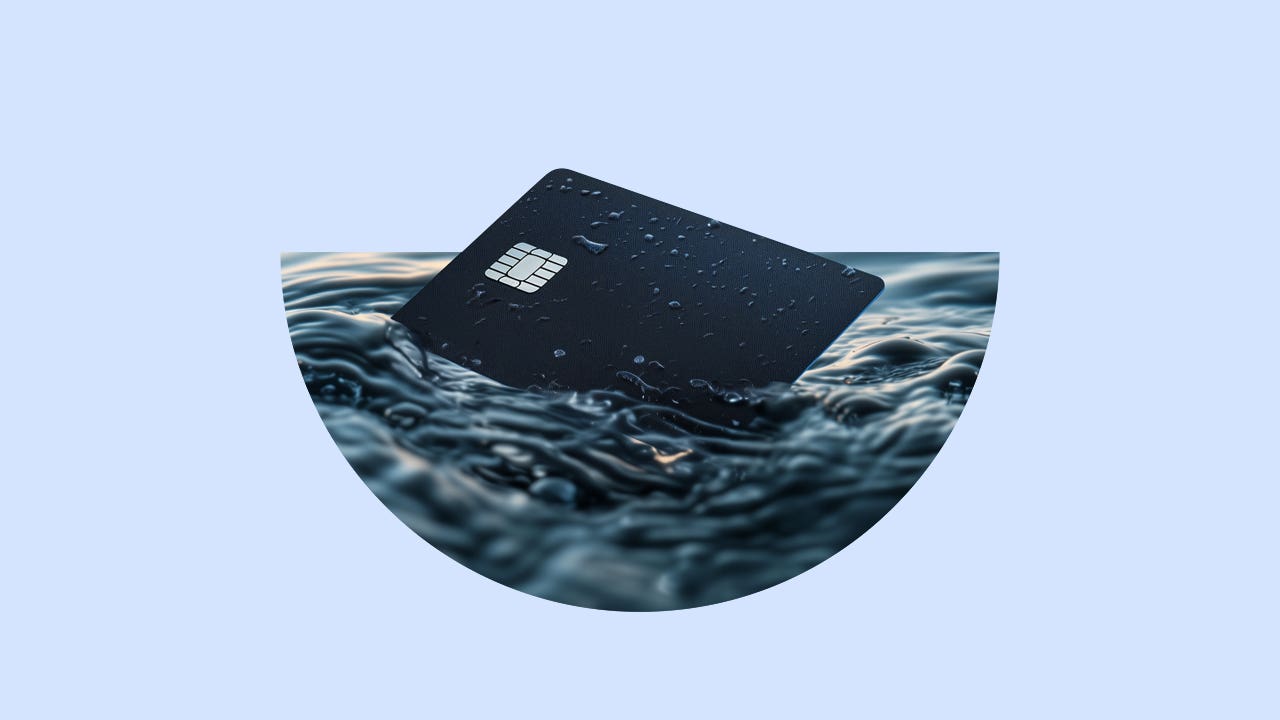Survey: Nearly 2 in 5 cardholders have maxed out a credit card or come close since the Fed started raising interest rates

In the aftermath of hot inflation and high interest rates, many Americans have been stretched so financially thin that they’ve borrowed up to the limit on a credit card, new data from Bankrate reveals.
Almost 2 in 5 cardholders (37 percent) have maxed out a credit card or come close since the Federal Reserve began raising interest rates in March 2022, according to Bankrate’s new Credit Utilization Survey. That includes 20 percent who have maxed out a card and another 17 percent who came close.
A maxed-out card can create a cascading set of problems for consumers. Their available credit dries up, limiting their options if they need to cover a necessary expense in a pinch, such as unexpected medical or household expenses. Credit reporting agencies also will notice that they’re using too much of their available credit (a situation the industry calls “high credit utilization”). This can hurt their credit scores, damaging their ability to qualify for additional credit limit increases and balance transfer cards that make the cycle of debt even worse. Not to mention, Americans who’ve run their credit taps dry could rob the U.S. economy from its crucial consumer-driven engine of growth on the precipice of a crucial holiday shopping season.
A few years of high inflation and high interest rates, and many households are struggling. Those who are most equipped to get through it are having an easier time getting credit, but it’s a different story for those with lower incomes and lower credit scores.— Ted Rossman, Bankrate Senior Credit Card Analyst
Key findings from Bankrate’s Credit Utilization Survey
Nearly 2 in 5 cardholders (37%) have maxed out a credit card or come close since the Fed started raising interest rates, Bankrate’s Credit Utilization Survey found. That includes 20% who have maxed out a credit card and 17% who have come close to maxing one out.
Over half of cardholders who’ve maxed out a credit card or come close (54%) blame inflation or high prices. Other top reasons include emergency expenses (38%) and carrying a balance or having credit card debt (32%).
Of those who have maxed out their credit card or come close, 88% say it negatively impacted their personal finances in some way. This includes 41% who said their credit score declined and 31% who say they could not afford a necessary expense.
These are the Americans who are using the most credit since the Fed started raising rates
The total debt borrowers have divided by the credit they have available — one’s utilization ratio— accounts for 30 percent of their overall credit score in FICO’s rating system, making it one of the most important factors in determining their creditworthiness. Experts typically advise using less than 30 percent of your available credit, though utilizing less than 10 percent is considered excellent.
Utilization rates at an aggregate, nationwide level seem stable, even as credit card debt hit a new record of $1.14 trillion in the second quarter of 2024, according to the New York Fed’s Household Debt and Credit Report. The average credit card utilization rate was 21.3 percent in August, in line with a historic norm since 2011 of 20-22 percent and below the 30 percent rule-of-thumb that experts typically recommend, according to Equifax data.
Bankrate’s findings, however, offer a closer examination, revealing that some pockets of distress could be forming as some groups — particularly those who have been vulnerable to inflation — utilize more credit than others. Equifax data also shows that utilization rates have surged from where they stood in March 2022 (18.6 percent). Back in April 2021, meanwhile, the average utilization rate hit the lowest levels ever recorded (18 percent).
According to Bankrate, the cardholders who were most likely to have maxed out, or come close to maxing out, their credit cards include:
- Parents with children younger than 18 (45 percent);
- Generation Xers, or those between the ages of 44-59 (45 percent); and
- Americans earning under $50,000 a year (45 percent).
Just 39 percent of cardholders who have children aged 18 or older have maxed out or come close, along with 33 percent of cardholders with no children.
More than 1 in 4 (27 percent) Gen X cardholders have maxed out their credit, while 17 percent have come close to maxing it out. That compares with 23 percent of millennials (ages 28-43) who have maxed out their credit and 18 percent who have come close, while 17 percent of baby boomers (ages 60-78) have maxed out and 15 percent have come close.
The youngest Americans — Generation Z cardholders (ages 18-27) — are more likely to have lower credit limits that lead to higher utilization rates, partially a feature of being new in their financial journey, according to New York Fed research. Yet, they are the least likely to report having maxed out a card (at 10 percent), though the most likely of the generations to have come close (at 21 percent), according to Bankrate’s survey.
When it comes to middle- and upper-income cardholders, 41 percent of both those who annually earn between $50,000 and $79,999 or between $80,000 and $99,999 have either maxed out a card or come close since the Fed started raising interest rates. Only 29 percent of those earning $100,000 or more a year have maxed out their credit or come close.
More than half (53 percent) of cardholders haven’t maxed out a credit card or come close since March 2022, Bankrate’s survey found. Another 4 percent don’t know, while 6 percent prefer not to say.
Americans who’ve maxed out a card or come close blame high prices, inflation for their credit woes
Over half of cardholders who’ve maxed out their credit card or come close since March 2022 (54 percent) blame inflation or high prices, the No. 1 culprit across income groups, age, region, gender and race.
Many households had no choice but to take on credit card debt — at a time when the cost of carrying a balance surged to the highest levels ever recorded. Just 44 percent of Americans say they would pay an unexpected $1,000 expense with cash from their savings account, according to Bankrate’s Emergency Savings Survey.
Credit card interest rates were never affordable, hovering around 16 percent when the Fed’s key interest rate was near-zero during the pandemic, Bankrate historic rate data shows. Yet, they’re currently still holding among the highest levels ever recorded, despite the Fed’s surprising half-point interest rate cut in September.
“The Fed’s rate hikes have made it more expensive to carry credit card debt, especially for those with lower credit scores,” says Michael Hershfield, CEO and Founder of Accrue Savings, a fintech platform. “This creates a cycle where growing balances and rising interest payments lead to faster max-outs, leaving consumers struggling to pay down debt.”
Money tip: Carrying just a $5,000 balance on a credit card — below the national average balance — at an interest rate worth 21% would take 23 years and almost $8,125 in interest to pay off if a borrower could only afford to make a minimum payment.
Meanwhile, inflation is no longer as hot as it was, dropping from a high of 9.1 in June 2022 to 2.4 percent as of the latest reading in September. Yet, slowing inflation does not equal falling prices, and many of the items Americans need — such as housing, utilities, groceries and more — have risen at a faster pace than overall prices since the outbreak.
Other reasons cardholders blame for maxing out a credit card or coming close include:
- emergency expenses (38 percent);
- carrying a balance or having credit card debt (32 percent);
- job or income loss (25 percent);
- medical costs (22 percent);
- too much discretionary spending (22 percent);
- not having a budget (16 percent); and
- home renovations (9 percent).
Another 5 percent cite some other reason, while 1 percent didn’t know.
‘You feel a sense of despair, that there’s no hope’
Susana’s credit cards became her emergency fund during the coronavirus pandemic. Her hours at a local health care clinic near her Virginia home where she worked got cut in half in March 2020, and a few months later, she also divorced from her husband.
Suddenly, the newly single 40-year-old mom, who asked to remain anonymous to talk freely about her debt situation, watched her household income drop at a time when her expenses were also surging from inflation.

She’s used her cards to cover everything from her family’s groceries for the week, to emergency car repairs, medical procedures that weren’t fully covered by insurance and early childhood screenings for her son. She ultimately went on to max out five credit cards and accrue about $70,000 in credit card debt. A quarter of the balance, she estimates, came from covering child care.
All the while, Susana’s rent jumped from $1,600 a month in July 2020 to $2,300 a month by the summer of 2024. She makes about $56,000 a year, and her pay has only gone up by a few dollars a year since 2020. One year, it didn’t increase at all.
Susana is on a debt repayment plan through credit counseling nonprofit Money Management International and is hoping to eventually pay back her debt by the end of this year. The financial stressors, however, have left scars on her mental health. She thinks back to childhood trips to Florida and later Ecuador, where she and her brother met many of their relatives, and wishes she could afford to do the same for her son.
“Being credit card debt free will be amazing, and I don’t ever intend to have it happen again. It was such a challenge to feel like I wasn’t making any dent. You feel a sense of despair, that there’s no hope,” Susana says. “But the concern I have is really for my son, and for the future. I cannot provide for my son the things I would’ve liked to be able to provide for him. It makes me sad, and it’s overwhelming and disheartening. I’m constantly thinking, ‘What can I do differently?’”
The majority say maxing out a card or coming close has negatively impacted their personal finances
Americans aren’t just relying on their credit cards for fun-filled purchases. Many are relying on them to make ends meet. And if their tap suddenly runs dry right when they need to make a purchase, they can be hit with major financial distress.
The majority of Americans (88 percent) who’ve maxed out a card or come close say the experience negatively impacted their personal finances in some way.
This includes those who say they:
- felt more stressed about the state of their finances (51 percent);
- had to cut back on spending (48 percent);
- saw their credit score decline (41 percent);
- could not afford a necessary expense (31 percent);
- had to borrow money from family or friends (22 percent); and
- had to pursue alternative financing, such as payday loans, cash advances, buy-now, pay-later products (16 percent).
Another 16 percent of Americans who maxed out a credit card or came close said they formed a debt payoff plan, while 15 percent applied for a credit limit increase and 10 percent applied for a balance transfer card.
Parents with children younger than 18 (22 percent) who have maxed out a card or come close were more likely than those with children aged 18 or over (12 percent) and those without children (18 percent) to say they had to pursue alternative financing after they almost hit or surpassed their credit limit.
White Americans were more likely to feel stressed about the state of their finances (56 percent), compared with 40 percent of Black Americans and 37 percent of Hispanic Americans.
Highlighting that rising stress, enrollments in credit counseling service GreenPath Financial Wellness’s debt management program have jumped 106 percent since August 2020, according to Andy Manthei, a business development specialist and financial counselor for the credit counseling service GreenPath Financial Wellness.
“Folks are getting to a point where they cover their gas, their groceries, and right at the tail end of the month, something comes up and they just can’t get to payday,” he says. “As the balance goes up, payments get higher, and it starts to spiral into this situation where they can’t actually bring it down.”
Americans who’ve maxed out their credit are more likely to have fallen behind on a bill
A high utilization ratio can often be a foreboding sign of more financial stress, a reason why creditors give it so much weight when calculating Americans’ credit scores.
“The whole credit industry has proven that [credit utilization] is positively correlated with consumers’ risk and probability with paying or not paying in the future,” says Charlie Wise, senior vice president and head of global research and consulting at TransUnion.
Bankrate’s data confirms that relationship. Since the beginning of 2024, 3 in 10 Americans (31 percent) say they have missed at least one monthly payment on a bill due to a financial reason and not because they forgot to make a payment.
Yet, those who have maxed out or come close to maxing out their credit cards since the Fed began raising interest rates are the most likely to have fallen delinquent at some point this year. More than half of this group (59 percent) say they have missed at least one monthly payment on a bill for financial reasons since the beginning of 2024.
The most common missed monthly payments include:
- utilities (15 percent);
- credit cards (14 percent);
- Rent or mortgage payments (8 percent);
- student loans (5 percent);
- a home equity loan (2 percent); or
- a home equity line of credit (3 percent).
Black Americans (41 percent) and Hispanic (39 percent) Americans are most likely to have missed at least one payment due to a financial reason since the start of the year, compared with 27 percent of White Americans.
Parents of young children and low-income Americans have also fallen behind on at least one bill since the start of the year. More than 2 in 5 (46 percent) Americans with children younger than 18 have missed at least one payment due to a financial reason since the start of the year. That compares with 27 percent of those who aren’t a parent or guardian, as well as 27 percent of those whose children are adult-aged.
Two in 5 (40 percent) Americans making less than $50,000 a year have missed at least one payment due to a financial reason, followed by 29 percent of those earning $50,000-$79,999, 28 percent of those making $80,000-$99,999 and 22 percent earning $100,000 or more.
Millennials, meanwhile, are the most likely of the generations to have missed a bill for a financial reason since the start of the year, at 42 percent, followed by 34 percent for both Gen Zers and Gen Xers and 17 percent of baby boomers.
Bottom line
Americans don’t have to carry a balance month-to-month for their utilization rates to matter. Yet, piling more spending on top of a lingering balance can make it harder to keep a healthy utilization rate. To break the cycle of debt and lower your utilization rate, consider taking these steps:
- Make multiple payments a month: Your utilization rate is calculated based on your card’s most recent statement. Even if you pay that balance in full and avoid interest, a high balance can still be bad for your overall credit score. One of Rossman’s top tips is splitting your monthly payment in half and making an extra mid-month payment to keep your statement balance low.
- Ask for a credit limit increase: Many credit card issuers let their customers request a credit limit increase directly within their account, but be sure to ask your issuer whether it’ll count as a hard inquiry. Too many hard credit checks could weigh on your overall score, resulting in another hit if you’ve already been keeping a high utilization rate.
- Pursue a balance-transfer card: One way to make significant headway on your debt repayments is transferring your balance to a balance-transfer card with an introductory 0 percent annual percentage rate (APR). Americans with larger balances or lower credit scores, however, might not qualify, while borrowers will still have to craft an aggressive repayment plan. Many cards transition their customers back to their regular APR after the intro period ends.
- If you can’t qualify for a balance transfer, consider working with a nonprofit credit counseling service: Americans who can’t qualify for a balance-transfer card might be able to work with a nonprofit credit counseling agency to lower their monthly payments and reduce their current interest rate. Participants in GreenPath’s debt management program reduced their interest rate from 28 percent to 7.3 percent, on average, after enrolling, a study by the nonprofit found.
- Continue to save, even if it’s just a little bit: Climbing out of credit card debt can take years, but it can often be accumulated in an instant. Many Americans might feel tempted to go all in on their debt repayments, but they may still find themselves reliant on credit cards if they don’t have an emergency fund.






